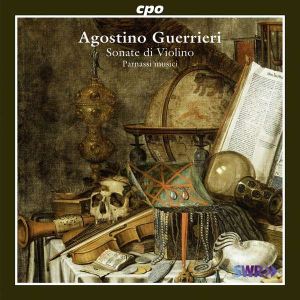 |
 |
|


alternatively
CD: MDT
AmazonUK
AmazonUS
Sound
Samples & Downloads |
Agostino GUERRIERI (c.1630
- c.1662)
La Sevescia, Sonata a 4 [2:59]
La Galeazza, Sonata a 2 violini [3:08]
La Sevaschina, a solo [3:42]
La Brignoli, Sonata a 2 Violini [3:10]
La Tità, Sonata a solo, Alpa doppia, overo Teorba
[5:29]
Giovanni Antonio Maria TURATI
(1608-1650)
La Viviani, Sonata a 3. Due Violini and Theorba [4:04]
Agostino GUERRIERI
Balletto prima, per camera [3:23]
La Lucina, Sonata a 2. Alpa doppia over Teorba and Violino
[6:17]
Balletto secondo, per camera [3:29]
Sonata malinconica, a solo [3:46]
La Marchetta, Sonata a 2 Violini [1:54]
La Benedetta, Sonata a 2 Violini [2:46]
La Rotini, a solo [5:45]
La Rosciana, Sonata a 2 Violini [2:40]
La Pietra, Sonata a 3. Due Violini and Basso di Viola [4:42]
Giovanni Antonio Maria TURATI
La Rovetta, Sonata a 4 [2:37]
 Parnassi musici (Margaret MacDuffy, Matthias Fischer (violin), Wolfgang
Wahl (viola), Stephan Schrader (cello), Sven Schwannberger (recorder,
theorbo), Masako Art (harp), Martin Lutz (organ))
Parnassi musici (Margaret MacDuffy, Matthias Fischer (violin), Wolfgang
Wahl (viola), Stephan Schrader (cello), Sven Schwannberger (recorder,
theorbo), Masako Art (harp), Martin Lutz (organ))
rec. 16-17 January, 9 July 2008, Hans-Rosbaud-Studio of SWR, Baden-Baden,
Germany DDD
 CPO 777 543-2 [59:58]
CPO 777 543-2 [59:58]
|
|
|
In the early 17th century not only the style of composing changed,
but also a whole new genre came into existence: the instrumental
sonata. Two instruments played a key role: the cornett and the
violin. During the 17th century the cornett was gradually moved
to the sidelines, whereas the violin became dominant. A large
repertoire for one or more violins was composed, and much of
it was quite virtuosic. Around the middle of the century the
form of the sonata started to change. Until then many sonatas
were divided into short sections of a mostly contrasting character.
In the last decades of the century composers began to divide
sonatas into various movements with specific indications in
regard to tempo and character. The sonatas by Guerrieri, from
which a selection is played here, document a stage in this development.
In the liner-notes Sven Schwannberger writes: "[A] bass line
that is (for its time) fairly richly figured, piano and
forte markings appearing at times with extreme frequency,
movement (or section) titles indicating form and tempo, and
the very detailed instrumentation for the basso continuo mark
this collection as a modern work of its day". Unfortunately
the indications for the various movements or sections are omitted
in the track-list.
We know next to nothing about Guerrieri, not even the exact
years of his birth and death. We do know that he was a pupil
of Giovanni Antonio Maria Turati (1608-1650) from Milan. A collection
of sacred music by Turati was published after his death by Guerrieri.
The latter's sonatas op. 1 include two sonatas by his teacher,
which are also recorded on the present disc. This collection
is the only extant music from Guerrieri's pen. The Sonate
di Violino a 1.2.3.4. per Chiesa and anco Aggionta per Camera
were printed in 1673 in Venice. It bears witness to the fact
that titles can mislead. The title of Guerrieri's set seems
to suggest that all the sonatas are for violins, but that is
not the case. La Tità is a solo sonata for harp
or theorbo with basso continuo; here it is played on the harp.
The theorbo is used in La Lucina, a sonata for harp or
theorbo, violin and bc. La Viviani by Turata also includes
a solo part for the theorbo.
In the title we also find the addition anco aggionta per
camera. This refers to the balletti which Guerrieri
included in this collection. The two balletti in this
recording are for a pair of treble instruments and basso continuo.
They are played with violin and recorder. The latter is also
used in various other pieces: La Sevaschina and the Sonata
malinconica. Schwannberger writes about documentary evidence
of the use of recorders in Italian music of that time, but doesn't
explain why exactly it is used in music which seems first and
foremost to be written for violin. Not that there is any objection
to that per se: it depends on the character of the music.
Sonatas which don't include specific violinistic passages, like
double-stopping, can perfectly well be played on the recorder.
The titles of the sonatas probably refer to people from Guerrieri's
environment or to colleagues of his. This was quite common practice
at the time. We find such titles also in the oeuvre of composers
like Legrenzi and Pandolfi Mealli. The names are often hard
to identify. Schwannberger suggests that La Rovetta,
one of the sonatas by Tirata, could refer to the composer Giovanni
Rovetta. La Viviani could be a reference to Giovanni
Buonaventura Viviani, a violinist and composer of Guerrieri's
time.
Some sonatas are quite virtuosic. That goes for La Rotini,
a solo sonata played here on the violin, and for La Lucina.
The performers have no problems whatsoever with the technical
requirements. Parnassi musici have made a series of recordings
for CPO which show their interest in rather unconventional repertoire,
such as Legrenzi, Vierdanck and Neruda. All of them are of high
quality, technically and musically, and that’s no different
here. The approach is lively, energetic and captivating. The
violinists take the main role, but I would especially mention
the contributions of Masako Art on the arpa doppia and
Sven Schwannberger on recorder and theorbo. The way this disc
has been put together guarantees a good amount of variety in
regard to scoring and character.
Anyone who likes to broaden his musical horizon should consider
this disc.
Johan van Veen
http://www.musica-dei-donum.org
https://twitter.com/johanvanveen
|
|

